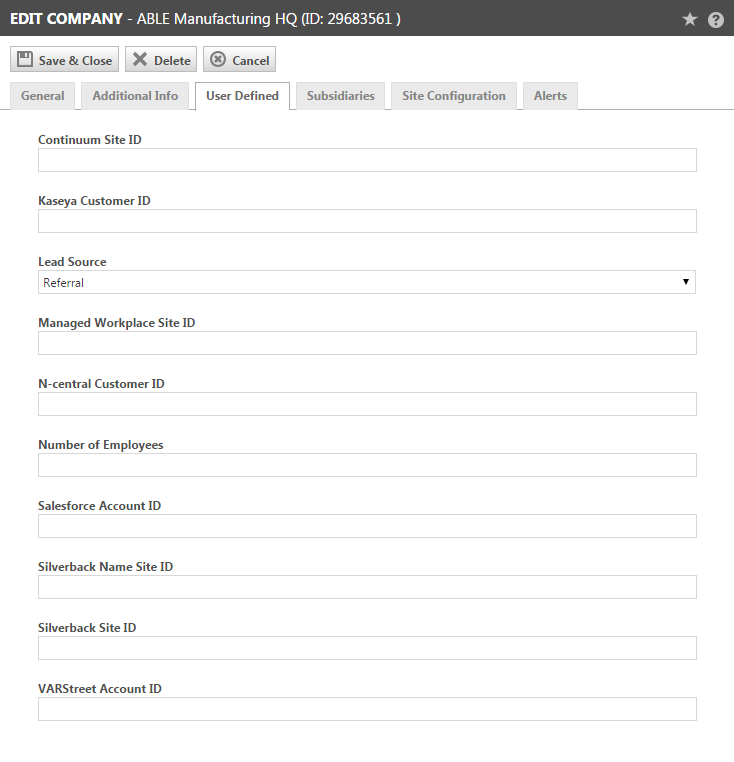System UDFs for remote monitoring extensions
When a remote monitoring extension is enabled, Autotask automatically generates system User-Defined Fields that are used to map Autotask organizations, devices or tickets to their equivalents in the remote monitoring application. UDF names include the name of the extension, such as, Kaseya Ticket ID.
NOTE If the remote monitoring extension is disabled, that extension's User-Defined Fields are automatically inactivated. They will be reactivated if the extension is enabled again.
This mapping happens when the Discovery Wizard is launched. Refer to Importing discovered devices into Autotask.
TIP A Customer ID column is available for selection from the Organization search table column chooser. A Device ID column is available for selection from the Device search table column chooser.
The following table provides a general description of the UDF types created in Autotask by the Kaseya Managed Services Extensions and their relationship to the XML elements used in the Add Ticket Email Service (ATES).
| This Autotask UDF | Maps these monitoring service entity types | To this Autotask entity type | Used with these ATES elements |
|---|---|---|---|
| Organization UDF: [Partner Application Name] Customer ID |
Customer ID |
Organization Entity | <CustomerID source=”[Partner Application Name]” name=”[value]”/> |
| Device UDF: [Partner Application Name] Device ID |
Device ID |
Device Entity | <DeviceID source=”[Partner Application Name]” name=”[value]”/> |
| Ticket UDF: [Partner Application Name] Alert ID |
Alert ID |
Ticket Entity | <AlertID source=”[Partner Application Name]” name=”[value]”/> |
| Ticket UDF: [Partner Application Name] Ticket ID |
Ticket Number | Ticket Entity | <TicketID source=”[Partner Application Name]” name=”[value]”/> |
IMPORTANT Attention Kaseya users: Refer to the Kaseya specific documentation for information specific to the Kaseya Organization Type UDF. Refer to Kaseya User-Defined Fields.
You cannot edit or delete Managed Services Extensions UDFs, but you are able to edit their content through the edit view of the associated entity:
- Access the Edit view of the Organization, Device or Ticket.
- Click the User-Defined Fields tab.
- Clear or edit the User-Defined Field. If you clear the field, the Autotask entity is no longer mapped to the managed service entity.
When integrating with ATES, Managed Services Extension users can include elements in the ATES XML token to provide data that corresponds to these UDFs. ATES uses the data to compare information in incoming alerts to existing tickets.
The following elements can be added to an ATES XML token to provide data for the Managed Services Extensions UDFs.
| Element Name | Required | Element Type | Element Value |
|---|---|---|---|
| CustomerID | No | Data (String) | Customer ID: Third party network monitoring applications can use this element to send a site identifier. If provided, ATES will look for the Autotask organization that is mapped (via a UDF) to the customer ID and attach this organization to the ticket. The corresponding organization UDF name is [Partner Application Name] Customer ID. |
| DeviceID | No | Data (String) | Device ID: Third party network monitoring applications can use this element to send a device identifier. If provided, ATES will look for the Autotask device that is mapped (via a UDF) to the device id and attach this device to the ticket. The corresponding device UDF name is [Partner Application Name] Device ID. |
| AlertID | No | Data (String) | Alert ID: Third party network monitoring applications can use this element to send an alert identifier. If provided, ATES will update a Ticket UDF with this alert value. The corresponding ticket UDF name is [Partner Application Name] Alert ID. |
| TicketID | No | Data (String) | Ticket ID: Third party network monitoring applications can use this element to send a ticket ID generated by the monitoring service. When an alert identifier is not available, this element can be used to define a duplicate ticket for multiple alert handling. It is also used by some monitoring services to enable round trip ticket closure. The corresponding ticket UDF name is [Partner Application Name] Ticket ID. |
NOTE For each of the above XML elements, the Managed Services Extension application must specify a source attribute value that indicates the application name. This value is used to construct the corresponding UDF.




